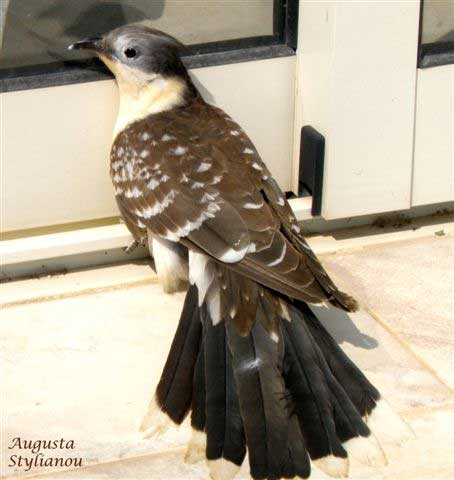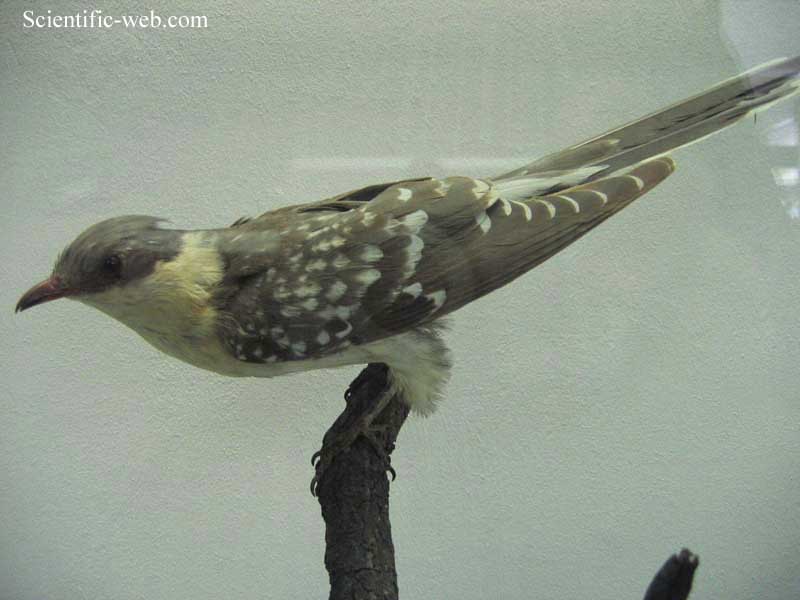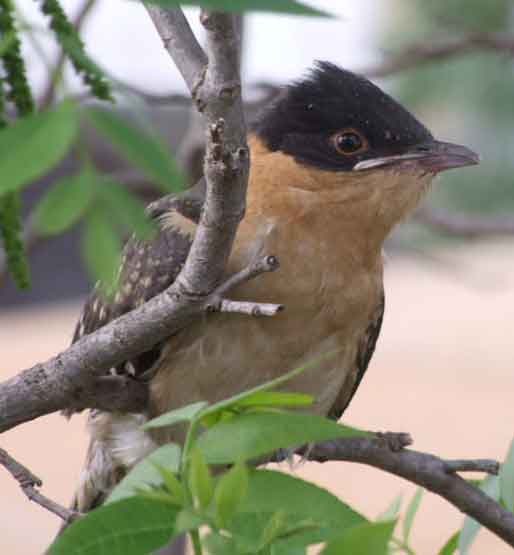
Clamator glandarius, Limassol district , Photo : Augusta Stylianou Artist
Superregnum: Eukaryota
Cladus: Unikonta
Cladus: Opisthokonta
Cladus: Holozoa
Regnum: Animalia
Subregnum: Eumetazoa
Cladus: Bilateria
Cladus: Nephrozoa
Superphylum: Deuterostomia
Phylum: Chordata
Subphylum: Vertebrata
Infraphylum: Gnathostomata
Megaclassis: Osteichthyes
Cladus: Sarcopterygii
Cladus: Rhipidistia
Cladus: Tetrapodomorpha
Cladus: Eotetrapodiformes
Cladus: Elpistostegalia
Superclassis: Tetrapoda
Cladus: Reptiliomorpha
Cladus: Amniota
Classis: Reptilia
Cladus: Eureptilia
Cladus: Romeriida
Subclassis: Diapsida
Cladus: Sauria
Infraclassis: Archosauromorpha
Cladus: Crurotarsi
Divisio: Archosauria
Cladus: Avemetatarsalia
Cladus: Ornithodira
Subtaxon: Dinosauromorpha
Cladus: Dinosauriformes
Cladus: Dracohors
Cladus: Dinosauria
Ordo: Saurischia
Cladus: Eusaurischia
Subordo: Theropoda
Cladus: Neotheropoda
Cladus: Averostra
Cladus: Tetanurae
Cladus: Avetheropoda
Cladus: Coelurosauria
Cladus: Tyrannoraptora
Cladus: Maniraptoromorpha
Cladus: Maniraptoriformes
Cladus: Maniraptora
Cladus: Pennaraptora
Cladus: Paraves
Cladus: Eumaniraptora
Cladus: Avialae
Infraclassis: Aves
Cladus: Euavialae
Cladus: Avebrevicauda
Cladus: Pygostylia
Cladus: Ornithothoraces
Cladus: Ornithuromorpha
Cladus: Carinatae
Parvclassis: Neornithes
Cohors: Neognathae
Cladus: Neoaves
Ordo: Cuculiformes
Familia: Cuculidae
Genus: Clamator
Species: Clamator glandarius
Name
Clamator glandarius (Linnaeus, 1758)
Original combination: Cuculus glandarius
Vernacular names
العربية: وقواق مرقط كبير
български: Качулата кукувица
brezhoneg: Koukoug safarus
català: Cucut reial
čeština: Kukačka chocholatá
Deutsch: Häherkuckuck
Ελληνικά: Κισσόκουκος
English: Great Spotted Cuckoo
Esperanto: Tufkukolo
español: Críalo
euskara: Kuku mottodun
suomi: Harakkakäki
føroyskt: Skjórugeykur
français: Coucou geai
galego: Cuco real
עברית: קוקייה מצויצת
magyar: Pettyes kakukk
հայերեն: Կկու փուլփուլավոր
italiano: Cuculo dal ciuffo
日本語: マダラカンムリカッコウ
Nederlands: Kuifkoekoek
norsk: Skjæregjøk
polski: Kukułka czubata
português: Cuco-rabilongo
русский: Хохлатая кукушка
svenska: Skatgök
Türkçe: Tepeli guguk
Tiếng Việt: Khát nước lớn
The great spotted cuckoo (Clamator glandarius) is a member of the cuckoo order of birds, the Cuculiformes, which also includes the roadrunners, the anis and the coucals.
It is widely spread throughout Africa and the Mediterranean Basin. It is a brood parasite that lays its eggs in the nests of corvids, in particular the Eurasian magpie.
Taxonomy
In 1747 the English naturalist George Edwards included an illustration and a description of the great spotted cuckoo in the second volume of his A Natural History of Uncommon Birds. He used the English name "The Great Spotted Cuckow". Edwards based his hand-coloured etching on a specimen that had been shot in Gibraltar and sent to the English naturalist Mark Catesby in London.[2] When in 1758 the Swedish naturalist Carl Linnaeus updated his Systema Naturae for the tenth edition, he placed the great spotted cuckoo with the other cuckoos in the genus Cuculus. Linnaeus included a brief description, coined the binomial name Cuculus glandarius and cited Edwards' work.[3] The great spotted cuckoo is now placed in the genus Clamator that was introduced by German naturalist Johann Jakob Kaup in 1829.[4][5] The species is monotypic: no subspecies are recognised.[5] The genus name Clamator is Latin for "shouter" from clamare, "to shout". The specific epithet glandarius is Latin meaning "of acorns".[6]
Description
This species is slightly larger than the common cuckoo at 35–39 cm (14–15 in) in length, but looks much larger with its broad wings and long narrow tail. The adult is grey above with a slender body, long tail and strong legs. It has a grey cap, grey wings, a yellowish face and upper breast, and white underparts. Sexes are similar. The juveniles have blackish upperparts and cap, and chestnut primary wing feathers. This species has a magpie-like flight.
It is a bird of warm open country with trees. It feeds on insects, spiders, small reptiles and hairy caterpillars, which are distasteful to many birds.
The great spotted cuckoo's call is a loud cher-cher-kri-kri and variations.
Behaviour
Breeding
Clamator glandarius in a clutch of Corvus cornix - MHNT
Unlike the common cuckoo, neither the hen nor the hatched chick of this species evict the host's eggs, but the young magpies often die because they cannot compete successfully with the cuckoo for food. However it has been shown that this species' chicks secrete a repellent scent when predators threaten. The repellent protects great spotted cuckoo chicks themselves as well as the host's chicks from predators.[7] Carrion crow (Corvus corone corone) chicks survive better if a great spotted cuckoo chick shares their nest. Birds of prey and feral cats less frequently prey on crow's nests that include a great spotted cuckoo chick. Crow chicks benefit only when predators are very active; when there is less predation, losing food to great spotted cuckoo chicks harms the crow chicks without compensation.[8][9]
References
BirdLife International (2016). "Clamator glandarius". IUCN Red List of Threatened Species. 2016: e.T22683819A86113703. doi:10.2305/IUCN.UK.2016-3.RLTS.T22683819A86113703.en. Retrieved 12 November 2021.
Edwards, George (1747). A Natural History of Uncommon Birds. Vol. Part II. London: Printed for the author at the College of Physicians. p. 57, Plate 57.
Linnaeus, Carl (1758). Systema Naturae per regna tria naturae, secundum classes, ordines, genera, species, cum characteribus, differentiis, synonymis, locis (in Latin). Vol. 1 (10th ed.). Holmiae (Stockholm): Laurentii Salvii. p. 111.
Kaup, Johann Jakob (1829). Skizzirte Entwickelungs-Geschichte und Naturliches System der Europaischen Thierwelt (in German). Darmstadt: In commission bei Carl Wilhelm Leske. p. 53.
Gill, Frank; Donsker, David; Rasmussen, Pamela, eds. (July 2021). "Turacos, bustards, cuckoos, mesites, sandgrouse". IOC World Bird List Version 11.2. International Ornithologists' Union. Retrieved 7 October 2021.
Jobling, James A. (2010). The Helm Dictionary of Scientific Bird Names. London: Christopher Helm. p. 110, 173. ISBN 978-1-4081-2501-4.
Great Spotted Cuckoo proved to protect invaded nests. Lne.es (2014-03-21). Retrieved on 2014-05-06.
Smelly cuckoos protect hosts' chicks from predators. Newscientist.com (2014-03-20). Retrieved on 2014-05-06.
The Stinky Way Cuckoo Birds Earn Their Keep. Livescience.com (2014-03-20). Retrieved on 2014-05-06.
Further reading
Ibáñez-Álamo, J.D.; Rühmann, J.; Pérez-Contreras, T.; Soler, M. (2019). "Migration behavior and performance of the great spotted cuckoo (Clamator glandarius)". PLOS ONE. 14 (1). e0208436. Bibcode:2019PLoSO..1408436I. doi:10.1371/journal.pone.0208436. PMC 6319774. PMID 30608941.
Retrieved from "http://en.wikipedia.org/"
All text is available under the terms of the GNU Free Documentation License



